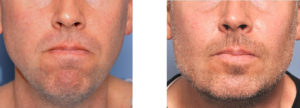I frequently get e-mailed and asked…’What can I do to get a stronger jawline?’ This is exclusively a male question and usually, but not always, is from a younger patient. In looking at a lot of photographs of male patients with this concern, the most common problem is that the chin is short and the jawline is ill-defined. Some cases are more severe while others are much more mild. In either case, the strong jawline of male models and some famous male actors has set a beauty standard for males to aspire to.
In making a jawline more distinctive, there are three areas to consider improving or highlighting. Anterior projection (chin), posterior lateral width (jaw angle) and inferior border or circumferential jawline are the areas that can be surgically augmented with implants. Other than the chin, there are no bony moving or bone grafting procedures that will work.
From a practical standpoint, the two most common and easiest implants to place are the chin and jaw angle. The available implants are well made with numerous styles (chin) and a good range of sizes that will fit all but the very largest, or most bony deficient, patients. By bringing the chin forward (and more square) and making the back of the jaw (jaw angle) wider, the jawline becomes much more distinctive. This approach will work for the vast majority of male patients.


There is an alternative to a piece-meal implant approach to total mandibular augmentation. A one-piece custom implant can be fabricated before surgery off of a 3-D CT mandibular scan of the patient. This is best used when the objective is vertical lengthening of the jawline as this is how it must be placed. It can not be used to provide posterior width like a traditional jaw angle implant.
Barry L. Eppley, M.D., D.M.D.
Indianapolis, Indiana


